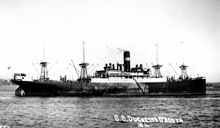| Operation Postmaster | |||||||
|---|---|---|---|---|---|---|---|
| Part of SOE operations and the Battle of the Atlantic | |||||||
 The Italian cargo liner Duchessa d'Aosta captured during the raid | |||||||
| |||||||
| Belligerents | |||||||
|
| |||||||
| Commanders and leaders | |||||||
|
|
| ||||||
| Strength | |||||||
|
Small Scale Raiding Force 11 men Special Operations Executive 4 men local volunteers 17 men HMS Violet (K35) |
Duchessa d'Aosta ship's crew 46 Bibundi ship's crew unknown Likomba ship's crew unknown | ||||||
| Casualties and losses | |||||||
| None | 29 crew and one merchant ship with 2 boats captured | ||||||
Operation Postmaster was a British special operation conducted on the Spanish island of Fernando Po, now known as Bioko, off West Africa in the Gulf of Guinea, during the Second World War. The mission was carried out by the Small Scale Raiding Force (SSRF) and the Special Operations Executive (SOE) in January 1942. Their objective was to board the Italian and German ships in the harbour and sail them to Lagos. The SSRF under the command of Major Gus March-Phillipps left Britain in August 1941 and sailed the Brixham trawler, Maid of Honour,[1] to the Spanish colony.
The British authorities in the area refused to support the raid, which they considered a breach of Spanish neutrality. Permission for the operation to go ahead eventually came from the Foreign Office in London. On 14 January 1942, while the ships' officers were attending a party arranged by an SOE agent, the commandos entered the port aboard two tugs, overpowered the ships' crews and sailed off with the ships, including the Italian merchant vessel Duchessa d'Aosta. The raid boosted SOE's reputation at a critical time and demonstrated its ability to plan and conduct secret operations no matter the political consequences.[2]
- ^ "Brixham Heritage Sailing Trawlers Archive, Maid Honour". Archived from the original on 2021-09-19. Retrieved 2021-05-07.
- ^ Binney, p.121